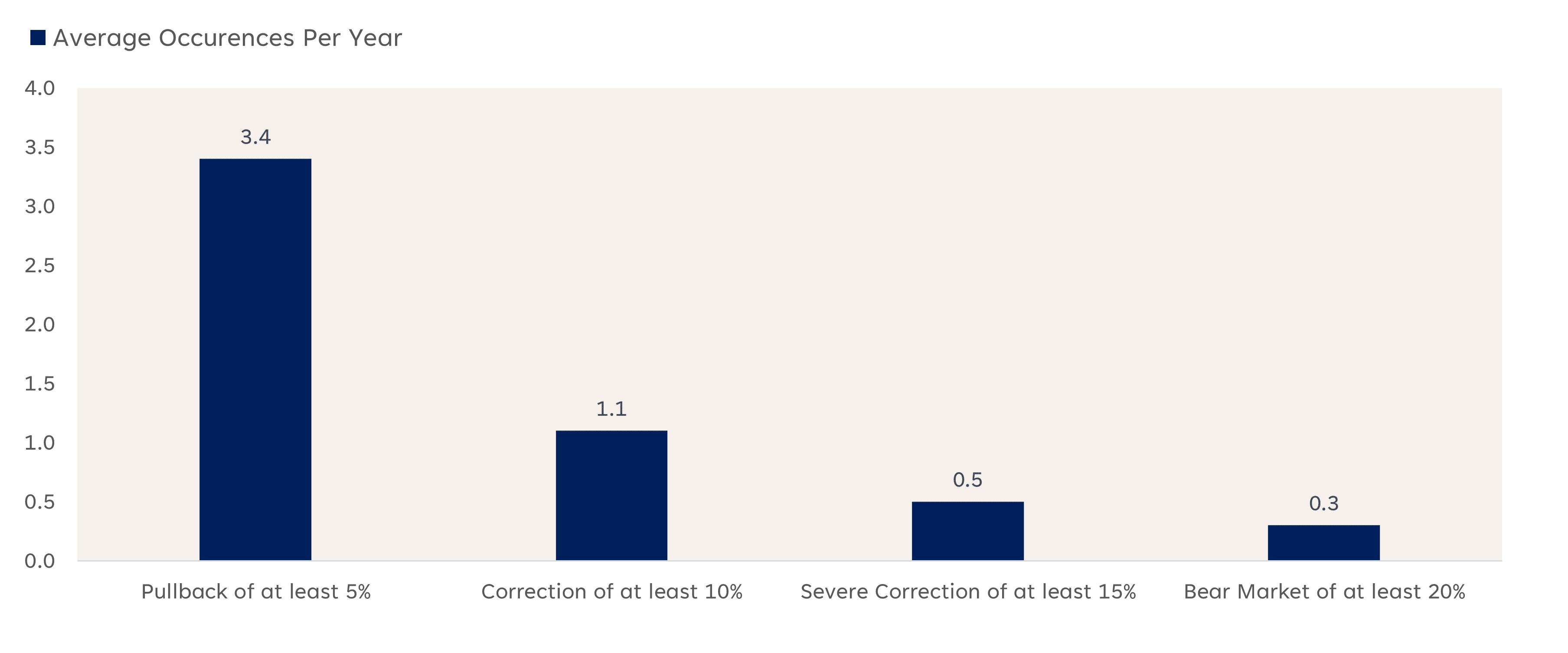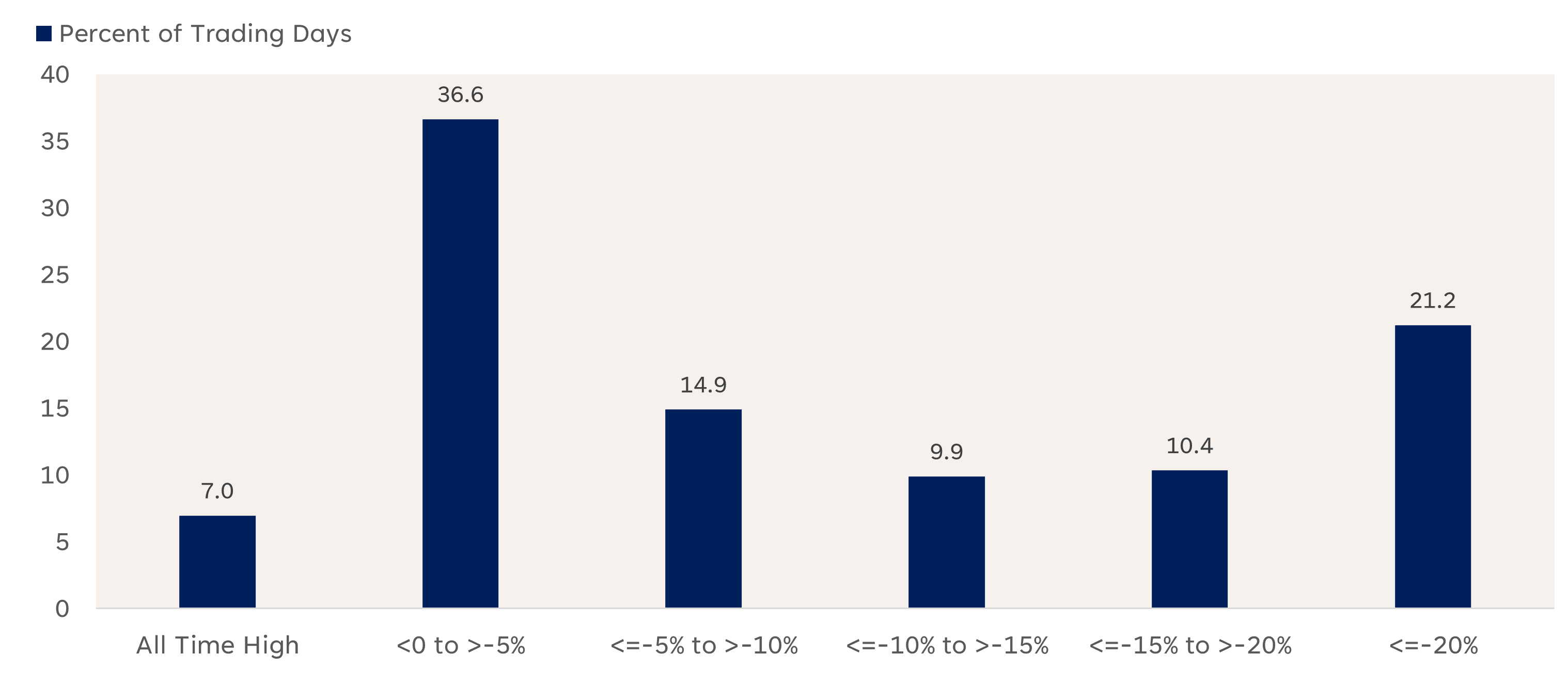While a correction may be unexpected, drawdowns in the market are the norm. The S&P 500 has been in some form a drawdown 93% of the time since 1950 (in other words, 7% of all trading days have been at record highs). As highlighted below, drawdowns of less than 5% from a record high are the most common, occurring in roughly 37% of all trading days. Pullbacks that exceed 5% but not 10% occur about 15% of the time, while bear market drawdowns of at least 20% represent roughly 21% of all trading days.

Source: LPL Research, Ned Davis Research 01/22/25
Analysis based on daily closing price of the S&P 500 from 01/03/1928 to 01/22/2025.
Disclosures: Past performance is no guarantee of future results. All indexes are unmanaged and can’t be invested in directly. The modern design of the S&P 500 stock index was first launched in 1957. Performance back to 1950 incorporates the performance of the predecessor index, the S&P 90.
S&P 500 Drawdown State (1950–YTD)

Source: LPL Research, Bloomberg 01/22/25
Analysis based on drawdowns from record highs on the S&P 500 since 1950.
Disclosures: Past performance is no guarantee of future results. All indexes are unmanaged and can’t be invested in directly. The modern design of the S&P 500 stock index was first launched in 1957. Performance back to 1950 incorporates the performance of the predecessor index, the S&P 90.
Are We Due Another Correction?
There are plenty of catalysts underpinning the recent advance in stocks. President Trump brings a pro-growth agenda to Washington, along with expectations of reduced regulations and the prospect of lower taxes. Several major bank CEOs have recently highlighted the elevated enthusiasm for the new administration among their corporate clients.
On last week’s earnings call, JPMorgan Chase’s CEO Jamie Dimon noted, “Businesses are more optimistic about the economy, and they are encouraged by expectations for a more pro-growth agenda and improved collaboration between government and business.”
Many of these major banks also reported fourth-quarter earnings that handily exceeded forecasts, adding another tailwind to the latest rebound. Outside of improving net interest margins and a jump in investment banking activity and trading revenue, there were also positive takeaways at the consumer level as credit and debit card sales notably picked up last quarter for several of the big banks.
At the macro level, a cooler-than-expected core Consumer Price Index (CPI) report last week helped assuage inflation fears and keep rate-cut expectations on the table. This translated into a sharp pullback in interest rates, including a notable 0.13% drop in 10-year Treasury yields. And while the pullback was encouraging, it was not enough to reverse the developing uptrend in yields. Technically, a move below support near 4.45% would be a good sign of the cycle high being reached earlier this month.
With the stock market nearing record-high levels, it might seem premature to talk about a potential correction — characterized by a market drawdown of 10% or more but less than 20%. However, bull markets are not linear, and corrections, though relatively improbable, are always possible.
According to our friends at Ned Davis Research, a correction has occurred every 1.1 years going back to 1928. Furthermore, the last time the market entered an official correction was 309 trading days ago, spanning well beyond the average number of 173 trading days without a correction since 1928.
Summary
While deviations between price and market breadth can persist for extended periods, they can often foreshadow building vulnerabilities of a rally susceptible to stalling. While we are not making a call for an imminent correction, investors should not be surprised if one develops this year as history shows they occur at least once per year.
LPL Research expects stocks to move modestly higher in 2025, while acknowledging reasonable upside and downside scenarios. Upside support could come from economic growth, a supportive Fed, strong corporate profits, and business-friendly policies from the Trump administration. The most likely downside scenarios involve re-accelerating inflation, higher interest rates, and geopolitical threats that do economic harm.
